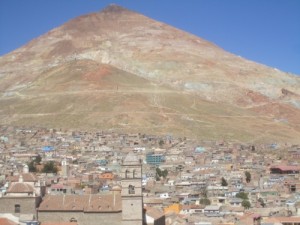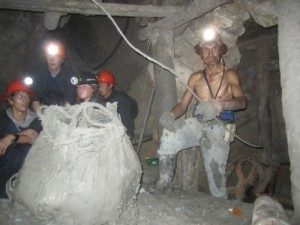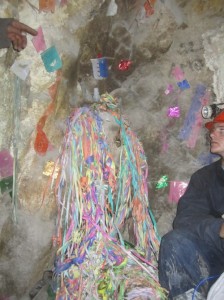Today, the Cerro Rico mountain’s dark legacy continues. It is the work location for thousands of local miners. Mining is the best paying job in town, but there are no safety regulations and miners as young as twelve years old work here. Miners work in a cooperative venture, with each miner claiming his own minerals. They sell the minerals to a smelter through the cooperative. Due to exposure to noxious chemicals, miners often die within ten years of entering the mines. The 2005 award-winning film The Devil’s Miner captures the hellish working conditions were.
The Cerro Rico mines and their dark legacy attract tourists to Potosi. They are what brought me here. I wanted to take a cooperative mine tour to get a glimpse of the working conditions in the mines. My tour would involve spending several hours inside the mines, crawling through shafts and down ladders, and seeing the miners in action. It would be a dangerous and eye-opening experience. Like living my own episode of Dirty Jobs. I chose a young tour company which was owned by ex-miners and supported the local community.
Preparation: Dynamite, 100-Proof Alcohol and Cigarettes
After changing into miner’s outfits and hard hats, my group made our way to the miner’s street market. Here, we purchased gifts for the miners. We bought the regular assortment of dynamite, 100-proof alcohol, coca leaves, cigarettes, soda, and work gloves.
Our guide had worked in the mines for three years before transitioning to the tour company. One of his brothers had died working in the mines at a young age. His father coped with this by drinking. His mother never got over her son’s death. As we drove towards the mines, he told us of the horrific working conditions of the mine we were about to visit.
“The average miner only lives to be 36. Many die due to black lung disease or accidents in the mines. Some boys start working here at the age of twelve. The cooperative has no safety regulations, so be careful. Twenty two miners have died in this mine last year due to accidents such as explosions and carbon minoxide poisoning,” he told us.
Entering the Mines
If there were a hell on earth, this would be it. The shafts were pitch black and we used head lamps to make our way around. We followed a path of rail tracks and a shallow pool of water. The height of the path varied. Most of the time, we had to bend down or crawl to get through the shafts. There were particles of silica dust floating around the whole time, especially in the shafts that had recently been dynamited. It was hard to breath as there wasn’t much ventilation.
During our two hours in hell, we met a number of interesting miners. Most of them only spoke Quechua, so our guide would interpret conversations for us. None of them wore masks or seemed to care about inhaling the dust. We gave them our gifts and took photos. Other than an annoyance when we got in the way, they didn’t seem to mind having tourists in the mines. They didn’t seem to hate their work either. There was an attitude of acceptance. Like it was their destiny to live this short and difficult life.
Devil Worship in Hell on Earth
The miners worship the devil, called Teo in Quechua. This makes sense given the mines close resemblance to hell. We came across two large devil statues in the mine, where sacrifices were strewn around. The miners believe that Teo helps them find good mining areas. When they dig further and discover a new region of minerals, they pay tribute to Teo with alcohol, soda, and coca leaves.
This was a real mine, and accidents could happen at any time. Runaway trains. Explosions. Falling rocks. Carbon minoxide poisoning. We had to constantly be on alert. We walked on rail tracks the whole way. Several times, our guide had us squeeze against a wall so trolley carts could go by. We barely missed getting ran over as there wasn’t much room beside the rail tracks. It took two or three men to push one of these carts, full of minerals.
The mine had six levels, but we only made it down to level three. After descending to level two, it became more difficult to breath and our bodies were covered in sweat. It was exhausting just walking around these mines. How did the miners have energy to work in these hellish conditions? I started to feel clostrophobic and an overwhelming fear of being stuck in the mines forever. It felt like a different planet. Over time, the darkness seemed to declare its permanence on us.
A Solo Miner
We met a solo cooperative miner, hacking away at a wall of silver mineral. He seemed content to have a few visitors. It must get lonely down here, I thought.
“Are you working here alone?” asked our guide.
“Yes” answered the miner.
“Why?”
“It’s not profitable to work this shaft in a group.”
“How much progress are you making on that wall?”
“About 30 centimeters per hour,” he answered, continuing to hack away at the wall.
There were no rail tracks between mine levels. This meant that the solo miner had to carry his minerals on his back up ladders and avoid deep pits along the way. We gave him some gloves, dynamite and cigarettes before leaving. Hopefully he saved the cigarettes for above ground. Exiting the mine, we felt a huge sense of relief to be back in the light. Only two hours in the mine had a tremendous impact on us. The miners would sometimes spend twenty four hours at a time down there.
An Eye-Opening Experience
As a sheltered tourist from a first world country, visiting the mines is an eye-opening experience. Cerro Rico’s dark legacy is not a thing of the past. How can the mining conditions still exist today? As tourists, are we helping or perpetuating the situation? We are helping ex-miners make a living, but at the same time we are giving gifts to the miners still working there. The only good that can come out of it is if we are changed by the experience. For me, I believe I was. After visiting the mines, I am less sheltered to the working conditions of the third world. If I ever start to feel sorry for myself, all I need to do is picture the miners of Potosi, Bolivia.
Part of the South of the Border Series


